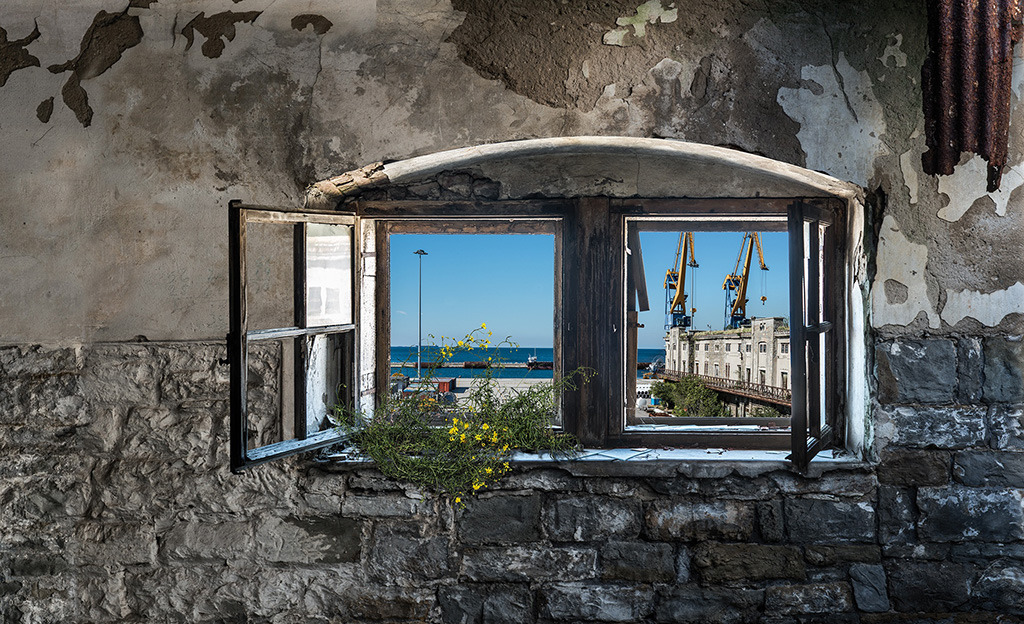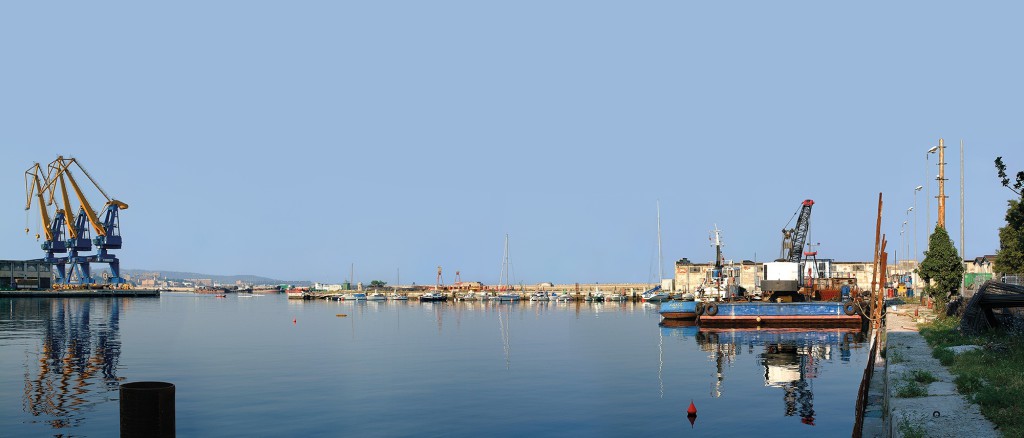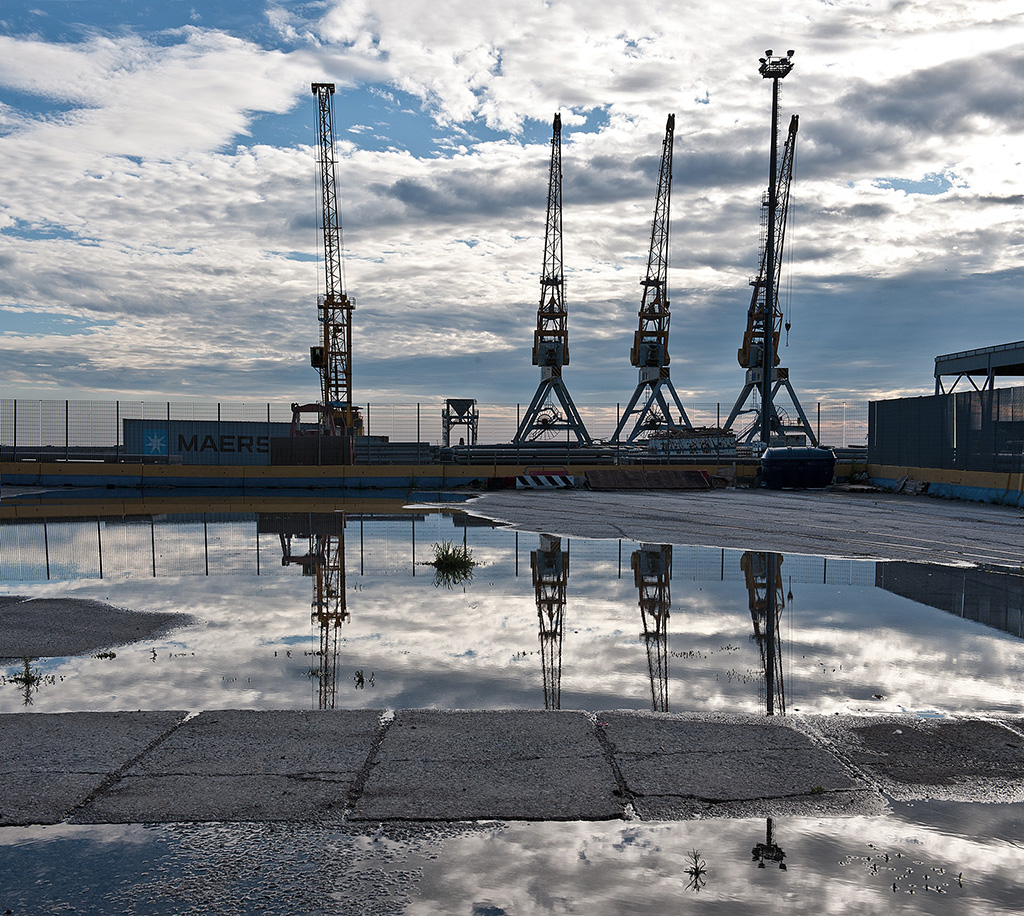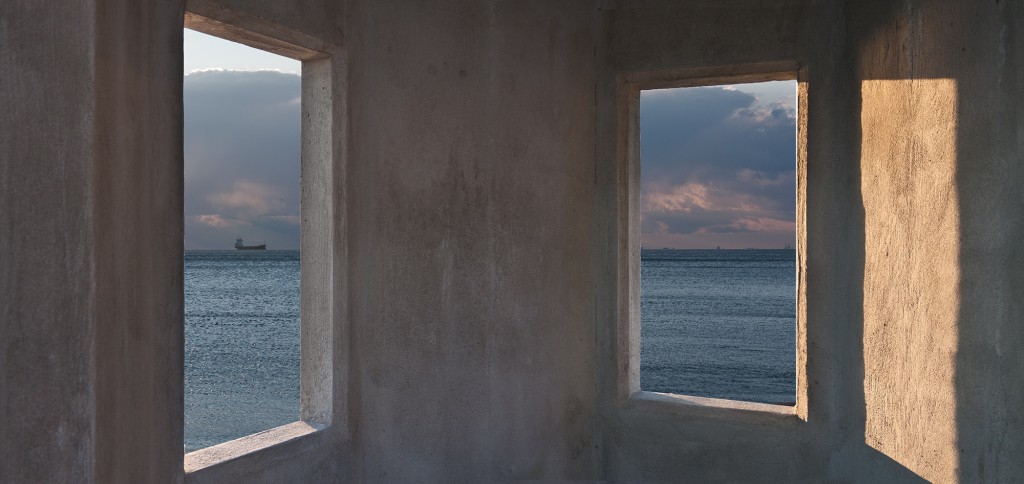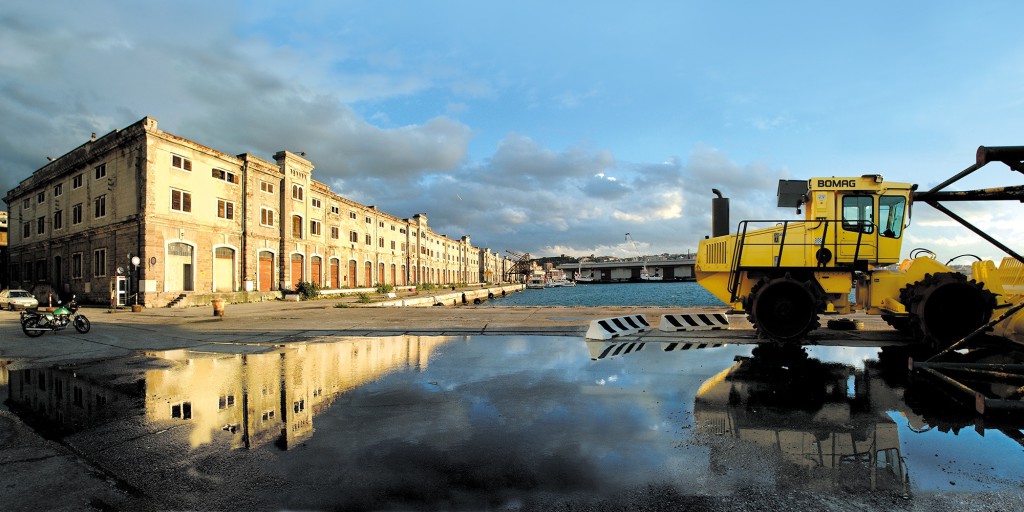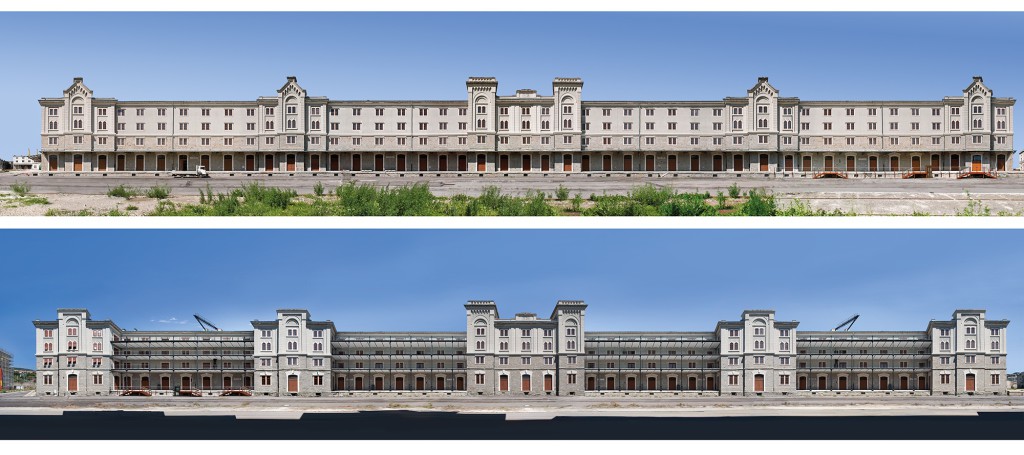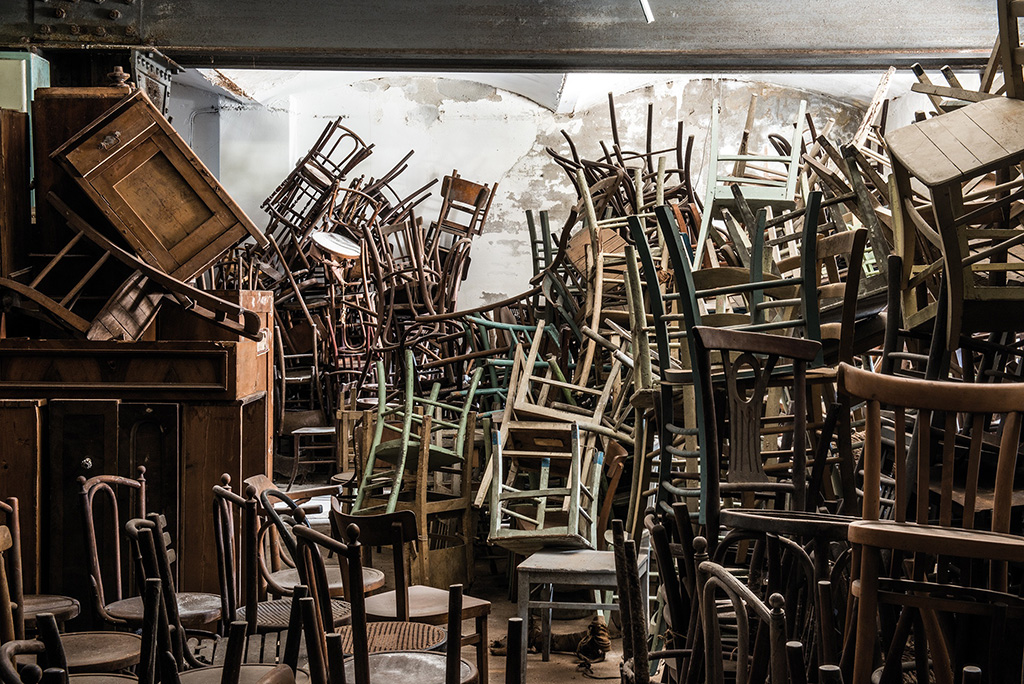In silence and discretion, the digital eye of the photographer from Trieste Neva Gasparo investigated, recorded and analyzed over a period thirty years long, every breath of Porto Vecchio (Old Port), in Trieste, an area of 600,000 square meters of warehouses, docks, sheds, garages, buildings and abandoned factories. Flatten against the Theresian Quarter, Porto Vecchio is ‘city within a city’. Designed in a unified way between the 60s and 80s of the Nineteenth century, the city became rich by becoming the port-emporium of the Austro-Hungarian Empire thanks to the rail link to Vienna. It was then quickly abandoned in favour of a new site, more functional to the rapid evolution of maritime transport, requiring deeper waters and a new organization of space.
Old Port is a port then unnamed, first called “new” then “old” compared to the one that would replace it, but born “free”, since the very beginning, for the functions that were performed. A name that now appears to emphasize even more the silence that dominates it.
Porto Vecchio is a condensed time for Trieste, where the grandeur of the past coexists with the abandonment and uncertainty of today and where you can also read the extraordinary potential to initiate new scenarios. Extraordinary architecture inhabit its spaces: deposits became part of the collective imagination as the Warehouse 18, where are still stored the belongings left by the Italian diaspora, as the first factory of the Stock or the Central hydrodynamics, maximum technological excellence in the panorama of the port era, which fed the movement of all the equipment through a network of high-pressure lines.
Porto Vecchio is a place full of dormant stories, forgotten or broken, a place inhabited by silent ghosts that cross the space now desolate and decadent. But, at the same time, a place full of signs and beauty, right in between the cracks of the walls and of its roofs, that also brings a promise for the future. This is something Trieste knows very well, for more than 40 years. Its rebirth or revival starts here and, if it has not been found yet the formula that allows to reconnect this wonderful ‘cathedral of work’ to the rest of the city that laps for hundreds of meters, it has never ceased to start from here during these long years.
They tried in many: a flurry of proposals and projects, many of them signed by the who’s who of international architecture, shocked, since the 60s of last century, the old stones and startled the buildings conquered by the wilderness, hosting surveys, calculations and measurements: from the assumption of radical transformation of the first projects to the reintegration of the Old Port in the urban fabric of Trieste, from a process of gradual transformation, to a new centrality to public spaces, to the maintenance of terminal related functions. Finally, on the basis of a master plan of the area built in 2007, it was chosen the hypothesis that involves the construction of a sort of citadel of tourism and recreational areas with three marinas, accommodation facilities and commercial areas for the shipbuilding industry and the crafts. A long process that will have to go through the cession as state property and its effective mending with the city of Trieste.
And it is this awareness that prompted Neva Gasparo to cross these spaces – full and empty, desolate and rich – in any season, any weather, sneak in a ‘prohibited’ city, to record its breath, coughing, tremors. To be present at every change of state, to take care of the temperature changes of a long-stay patient. Thus, not only to verify that the degradatio time deposits on the roofs, or the thorns that take over, but to highlight what the Old Port is in its very essence: an open window on a sea of possibilities.
Is reproduced below a selection of photographs contained in the book.
Window open on Porto Vecchio. (©Neva Gasparo)
Basin, in the 90s. (©Neva Gasparo)
Adria Terminal plaza. (©Neva Gasparo)
Dock 0 Watchtower. (©Neva Gasparo)
Hydrodynamic station in the 80s. (©Neva Gasparo)
Hangar 06, in the 90s. (©Neva Gasparo)
Warehouse 26 façades after renovation. (©Neva Gasparo)
Warehouse 18, belongings left by the Italian diaspora. (©Neva Gasparo)
Information
Senza far rumore. Viaggio in Porto Vecchio
Neva Gasparo
Lint, 2013
Neva Gasparo
Neva Gasparo lives and works in Trieste, where began his career as a photographer by chance in the seventies, working with Franco Basaglia, engaged at the time in the radical reform of the Psychiatric Hospital of Trieste. She specializes in reproductions of art, architecture, industrial, brownfield sites and social reportage. She discovered, over thirty years ago, the Old Port of Trieste, and she has fallen in love at first sight and since then has not stopped to photograph it. The photos presented here are part of her latest work entitled Senza rumore. Viaggio in Porto Vecchio (Noiselessly. Travel in Porto Vecchio), released in Trieste, for the types of Lint, in November 2013.
Head Image: Hangar 09 (anni 80). (©Neva Gasparo)
Senza far rumore. Viaggio in Porto Vecchio
In silenzio e con discrezione, l’occhio digitale della fotografa triestina Neva Gasparo ha indagato, registrato, analizzato, nell’arco di trenta lunghi anni, ogni respiro di Porto Vecchio, a Trieste, una superficie di 600.000 metri quadri di magazzini, moli, banchine, rimesse, officine, edifici e fabbriche abbandonate.
Addossato al Borgo Teresiano, Porto Vecchio è ‘città nella città’. Progettato in modo unitario tra gli anni ‘60 e gli anni ’80 dell’Ottocento, rese ricca la città diventando il porto-emporio dell’impero Austro-Ungarico grazie al collegamento ferroviario per Vienna. Venne poi presto abbandonato a favore di un nuovo sito, più funzionale alla rapida evoluzione dei trasporti marittimi che richiedeva fondali più profondi e una nuova organizzazione degli spazi.
Porto Vecchio è quindi un porto senza nome, prima chiamato “nuovo” poi “vecchio” rispetto a quello che lo avrebbe sostituito, ma sin da subito nato “franco” per le funzioni che vi erano svolte. Una denominazione che oggi sembra enfatizzare ancor più il silenzio che lo domina.
Porto Vecchio è per Trieste un condensato del tempo, dove la grandezza del passato convive con l’abbandono e l’incertezza dell’oggi e dove si leggono però anche le straordinarie potenzialità di avviare nuovi scenari. Straordinarie architetture abitano i suoi spazi: depositi entrati a far parte dell’immaginario collettivo come il Magazzino 18 dove sono ancora stoccate le masserizie lasciate dagli italiani della diaspora, la prima fabbrica della Stock o la Centrale idrodinamica, massima eccellenza tecnologica nel panorama portuale dell’epoca, che alimentava il movimento di tutti gli apparati attraverso una fitta rete di tubazioni ad alta pressione.
Porto Vecchio è quindi oggi un luogo pieno di storie sopite, dimenticate o interrotte, un luogo abitato da silenti fantasmi che ne attraversano gli spazi ormai desolati e decadenti. Un luogo però pieno di segni e di bellezza che, proprio tra le crepe dei suoi muri e dalle fessure dei suoi tetti, fa emergere anche una promessa per il futuro. Perché questo Trieste lo sa da oltre 40 anni. La sua rinascita o rilancio parte da qui e se ancora non si è trovata la formula che permette di riconnettere questa meravigliosa cattedrale del lavoro al resto di quella città che lambisce per centinaia di metri, non si è mai smesso, in questi lunghi anni, di partire da qui.
Ci hanno provato in molti: un fermento di proposte e progetti, molti dei quali firmati dal gotha dell’architettura internazionale, ha scosso, sin dagli anni ’60 del secolo scorso, le vecchie pietre e fatto sussultare gli edifici conquistati dalla natura selvaggia, ospitando sopralluoghi, misurazioni, calcoli e rilievi: dall’ipotesi di radicale trasformazione dell’area dei primi progetti alla reintegrazione di Porto Vecchio nel tessuto urbano di Trieste, dalla trasformazione per fasi, a una nuova centralità agli spazi pubblici, al mantenimento di funzioni terminalistiche. Infine, sulla base di un Masterplan dell’area realizzato nel 2007, venne scelta l’ipotesi che prevede la realizzazione di una sorta di cittadella del turismo e della nautica da diporto con tre marine, attrezzature ricettive e commerciali, aree per la cantieristica e l’artigianato. Un processo lungo che dovrà passare attraverso la sdemanializzazione dell’area e la sua effettiva ricucitura con la città di Trieste.
Ed è proprio questa consapevolezza che ha spinto Neva Gasparo ad attraversare questi spazi – pieni e vuoti, desolati e ricchi – in ogni stagione, con ogni condizione meteorologica, intrufolandosi in una città “proibita”, per registrarne il respiro, i colpi di tosse, i sussulti. Per essere presente ad ogni cambiamento di stato, per accudire gli sbalzi di temperatura di un malato lungodegente. Non solo quindi per verificarne il degrado che il tempo deposita sui manufatti, sui tetti squarciati, sui rovi che prendono il sopravvento, ma per mettere in risalto ciò che Porto Vecchio è nella sua essenza più intima: una finestra aperta su un mare di possibilità.
Viene riprodotta di seguito una selezione di fotografie contenute nel libro.
Finestra aperta su Porto Vecchio. (©Neva Gasparo)
Bacino (anni 90). (©Neva Gasparo)
Piazzale Adria Terminal. (©Neva Gasparo)
Molo 0 Garitta. (©Neva Gasparo)
Centrale idrodinamica (anni 80). (©Neva Gasparo)
Hangar 06 (anni 90). (©Neva Gasparo)
Facciate magazzino 26 dopo il restauro. (©Neva Gasparo)
Magazzino 18, masserizie lasciate dagli italiani della diaspora. (©Neva Gasparo)
Information
Senza far rumore. Viaggio in Porto Vecchio
Neva Gasparo
Lint, 2013
Neva Gasparo
Neva Gasparo vive e lavora a Trieste dove ha iniziato casualmente la carriera di fotografa negli anni settanta, collaborando con Franco Basaglia, allora impegnato nella riforma radicale dell’Ospedale Psichiatrico di Trieste. È specializzata in riproduzioni d’arte, architettura industriale, aree dismesse e reportage sociali. Ha scoperto, oltre trent’anni fa, il Porto Vecchio di Trieste, se ne è innamorata a prima vista e da allora non ha più smesso di fotografarlo. Le foto qui presentate fanno parte del suo ultimo lavoro intitolato Senza far rumore. Viaggio in Porto Vecchio, uscito a Trieste, per i tipi di Lint, nel novembre 2013.
Head Image: Hangar 09 (anni 80). (©Neva Gasparo)
